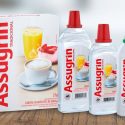What is Aspartame (E951) in food? Uses, Safety, Side effects and More

Production | Uses | Safety | Benefits | Side effects | FAQs
Aspartame, with the advantage of zero-calorie and sweet taste close to table sugar, it has been used as a sugar replacement in food and drink for around 40 years with the European food additive number E951.
However, this artificial sweetener is the most controversial high-intensity sweetener in recent years due to its possible side effects, although approved safely by the FDA, EFSA, JECFA and other authorities.
The global market demand of aspartame is about 20,000 – 25,000 MT annually. Approximately 75-85% of the total output is from China. China exported around 18,000 MT in 2019.
How is Aspartame Made?
Generally, aspartame can be commercially produced from the chemical reaction among L-aspartic acid, L-phenylalanine and methanol. There are several synthesis methods that can be used. The following are the four brief manufacturing processes that came up by the China manufacturer – Yamei (1), who closed in 2017.
Anhydride reaction (Step 1): the reaction among formic acid, acetic anhydride, and L-aspartic acid to obtain N-formyl-α-L-aspartic anhydride.
Condensation (Step 2): then react N-formyl-α-L-aspartic anhydride with L-phenylalanine and sodium hydroxide to produce N-formyl-a-L-aspartyl-L-phenylalanine.
Esterification (Step 3): then react with methanol and hydrochloric acid to obtain α -L-aspartyl-L-phenylalanine methyl ester hydrochloride.
Neutralization (Step 4): then neutralize with Na2CO3 to produce N-L-alpha-Aspartyl-L-phenylalanine-1-methyl ester (aspartame).
Property
| Other names | N-L-alpha-Aspartyl-L-phenylalanine-1-methyl ester, Aspartyl phenylalanine methyl ester, APM |
| CAS number | 22839-47-0 |
| Chemical formula | C14H18N2O5 |
| Molecular weight | 294.31 |
| PH | 0.8% solution is between 4.5 and 6.0 |
| Solubility | sparingly soluble in water (approximately 10 g/L at room temperature), and slightly soluble in alcohol (0.37 % in ethanol and insoluble in oil) |
Appearance
A white, crystalline powder or granular.
Taste
With a sweet taste of pure, refreshing and strong, approximately 200 times as sweet as sucrose, and the taste is very similar to it. Without the bitter, chemical or metallic aftertaste often found in other artificial sweeteners.
Synergy
Synergistic with other sweeteners. For example, when aspartame and acesulfame potassium are mixed with the ratio of 1:1, the sweetness can reach to 300 times sweet than sucrose, while both the sweetness is 200 times if used alone.
Which means the desired sweetness can be obtained with less amount of sweeteners. Meanwhile, aspartame can mask the bitter and astringent taste of other sweeteners such as sodium saccharin.
A further benefit of synergy is to reduce the instability of aspartame in soft drinks. When aspartame is mixed with another more stable sweetener, the shelf life of soft drinks can be extended.
Structure
Unlike other artificial sweeteners, the structure of this ingredient is made of two amino acids (l-aspartic acid and l-phenylalanine), and also with methanol. It can be metabolized and absorbed in the body like protein.

Image Source
The functional groups are carboxyl, ester, primary amine, amide, and phenyl.
What’re the Uses of Aspartame?
The purpose of aspartame in food is to reduce sugar and calories intake. And you may find it in many food, and here is a common food list that may with it:
- Carbonated soft drinks
- Powdered drink
- Instant coffee and tea beverages
- Fruit juice
- Tabletop sweeteners
- Dairy products
- Frozen desserts, puddings
- Yogurts
- Chewing gum
- Breath mints
- Candy
- Cereals
However, it cannot be used in cooking or baking as aspartame is not stable and will hydrolyze (break down) into amino acids in heating temperature above 80 degree. Other artificial sweeteners (e.g. sucralose, acesulfame k, sodium cyclamate, sodium saccharin, neotame) and more stable and so that they can be used in this field.
Sugar is often used as the sweetener in the traditional food, but with the disadvantages of causing obesity, cardiovascular diseases, dental caries, harmful to diabetics and other health problems. Having realized such side effects, many people are very sensitive to the sucrose content in foods, and thus turn to sugar free and low-calorie foods.
The function of aspartame is as a sugar substitute. It is about 200 times sweeter than sugar. And its calories can be ignored as the amount needed to make people feel sweet is so small, although one gram of aspartame has about 16.72 kJ calories.
Carbonated soft drinks
The uses of aspartame in carbonated beverages are in the first place of its total applications since first introduced in the early 1980s. Sucrose and high fructose corn syrup are the primary sweeteners used in traditional carbonated soft drinks.
Pepsico
Coca-Cola and Pepsi both use Aspartame in their diet coke, but Diet Pepsi was aspartame-free in the U.S. market in 2015 and used sucralose and stevia as replacements per some customers’ claimed that aspartame was not safe in 2015 (2). However, it relaunched Diet Pepsi with aspartame due to the sales sharp decline in 2016. (3)
And now we can see sucralose and acesulfame k are the primary artificial sweeteners than aspartame in its beverages. (4)
Aspartame is also used in Diet Mountain Dew. (5)
Coca-Cola
The purpose of aspartame in Coca-Cola’s drinks is to provide less sugar and fewer calories, while offering great tasting beverages.
The following common drinks contain aspartame except Coca-Cola Classic taste which is sweetened with either high fructose corn syrup or cane sugar (6):
- Coke Zero Sugar
- Diet Coke
- Fanta Zero
- Sprite Zero
The stability of aspartame in water is mainly determined by the pH value. It is most stable when the pH is 4.3 at room temperature. Since the pH of most beverages is between 3 and 5, so aspartame in beverages is very stable.
How much aspartame is used in Diet Coke, Coke Zero, Diet Pepsi and other drinks?
A 2010 data showed the number in an 8-ounce bottled or canned soda may as follows (7):
- Diet Coke: 125 mg
- Coke Zero: 58mg
- Sprite Zero: 50mg
- Diet Pepsi: 118mg
- Diet Dr Pepper: 123mg
Does Dr Pepper have aspartame in?
Yes, Diet Dr Pepper, Diet Caffeine Free Dr Pepper, Diet Cherry Vanilla Dr Pepper and Diet Dr Pepper Cherry contain aspartame, while the following Dr Pepper products are aspartame free (8):
- Dr Pepper
- Caffeine Free Dr Pepper
- Cherry Vanilla Dr Pepper
- Dr Pepper Cherry
Does Sparkling Ice have aspartame?
No, Sparkling Ice products are sweetened by sucralose instead of aspartame. (9)
Does 7UP have aspartame?
Yes, Diet 7UP and 7UP diet cherry with aspartame, whereas Cherry 7UP and original 7UP are sweetened with high fructose corn syrup. (10)
Powdered drink mixes
Powdered drink is another main food category that aspartame used. Aspartame can be used to blend with other ingredients (e.g. citric acid, calcium phosphate, maltodextrin, ascorbic acid, maltitol, xanthan gum, soy lecithin, colors and flavors) to make powdered drink dry mixes for sugar-free or reduced in calories.
And you’ll see it in the ingredient list of sugar free Tang (11)- A Mondelez popular powder drink.
Table top sweeteners
Aspartame and maltodextrin (to make it easy to distribute) may be used together to make sachets.
Chewing gum
It can be used together with sugar alcohol (e.g. sorbitol, maltitol) in sugar free gum. You can find it in the ingredient list of Eclipse sugar free gum. (12)
Yogurt
Aspartame is suitable for sweetening yogurt. It is added after pasteurization but before fermentation in the production of set yogurt, or put after fermentation for stirred yogurt. (13)
Confectionery
Aspartame is used in place of sugar to manufacture reduced-calorie and sugar-free confectionery. It provides sweetness similar to sucrose, lower in calories and without generating dental caries, so it is widely used in candy and chocolate.
Frozen desserts
It is a choice for the use in no sugar added, sugar-free frozen desserts and novelties. Such as in yogurts and ice cream.
Pharmaceuticals
It is an excipient used as a sugar alternative in pharmaceuticals to mask the undesirable taste.
What’re the Benefits of Aspartame?
Aspartame is the ideal alternative to sugar with the benefits as follows:
- Sugar-like taste, no bitter aftertaste
- Zero Glycemic Index: suitable for diabetics
- Made from amino acids: naturally digested and metabolised
- Low in calories
- Tooth-friendly
- Weight control
- Highest ADI (acceptable daily intake) among all artificial sweeteners
Good for diabetics
Due to the zero glycemic index (GI number), it will not increase the blood sugar or insulin level. So it is safe to consume for diabetics.
Weight control
Because products sweetened with aspartame are lower in calories than sugar-sweetened products, so aspartame may help with weight management.
The scientific studies at Harvard showed that aspartame or other low- or zero-calorie sugar substitutes (including artificial sweeteners, sugar alcohols and natural sugar substitutes) can benefit in losing weight in the short term. (14)
Highly acceptable daily intake of all low calorie sweeteners
The Acceptable Daily Intake (ADI) of aspartame is 50 milligrams per kilogram body weight per day (mg/kg bw/d), while the number for other artificial sweeteners are as follows (15):
- Advantame: 32.8
- Acesulfame K: 15
- Saccharin: 15
- Sucralose: 5
- Neotame: 0.3
Tooth friendly
The American Dental Association (ADA) has claimed that sugar substitutes (e.g. aspartame, erythritol, isomalt, sorbitol, mannitol) don’t promote decay-causing acids in your mouth that can harm teeth. (16)
Low Calorie
It is a non-carbohydrate sweetener, with the calorie 16.72 kJ/g, but only 1/200 of sucrose is needed to achieve the same sweetness. So its calorie brought to food can be ignored.
Is Aspartame Safe to Eat?
Yes, its safety has been approved by the U.S. Food and Drug Administration (FDA) and European Food Safety Authority (EFSA), as well as the Joint FAO/WHO Expert Committee on Food Additives (JECFA).
FDA
Aspartame may be safely used in food as a sweetening agent and a flavor enhancer in accordance with good manufacturing practice. (17).
It was discovered in 1965 and was approved by the FDA 1981 in tabletop sweetener, hot beverages (coffee and tea), cold breakfast cereals, chewing gum and other related applications after more than 100 scientific studies. (18)
FDA approved its use in carbonated beverages in 1983. (19)
EFSA
Aspartame (E951) is listed in Commission Regulation (EU) No 231/2012 as an authorised food additive and categorized in “ Sweeteners” (20).
Response to carcinogenicity from the study of Ramazzini Foundation
EFSA concluded there was no sufficient evidence to support the conclusion of the European Ramazzini Foundation (ERF) and there was no indication of any genotoxic or carcinogenic potential of aspartame and no reason to revise the previously established ADI.” (21)
Safety re-evaluation in 2013
EFSA concluded aspartame was not of safety concern at the ADI of 40 mg/kg bw/day (not applicable to PKU patients) and therefore maintained this ADI.
EFSA also approved the safety of aspartame hydrolysis metabolites: phenylalanine, aspartic acid and methanol.
Plus, the impurities 5-benzyl-3,6-dioxo-2-piperazine acetic acid (DKP) and β-aspartame. (22)
Approved uses
The maximum usages range from 25 to 6000 mg/kg in foods, except quantum satis for tabletop sweeteners. The following energy-reduced or/and no added sugar food may contain it (23):
- Canned or bottled fruit and vegetables
- jams jellies and marmalades
- Cocoa and Chocolate products
- Chewing gum
- Sauces
- Breakfast cereals
- Table-top sweeteners in powder/liquid/tablets form
- Flavoured drinks
UK Food Standards Agency
Categorized in “Sweeteners” (24)
Food Standards Australia New Zealand
It is an approved ingredient in Australia and New Zealand with the code number 951. (25)
JECFA
Function Class: food additives, sweetener. (26)
Acceptable daily intake: ADI “0-40 mg/kg bw” set in 1981. (27)
What are the Possible side effects of Aspartame?
Aspartame is the most investigated sweetener and its safety has been approved by the FDA and EFSA. However, many controversies often claim this ingredient is bad for your health and the following are its lists of possible side effects besides dangerous to people with PKU:
- Cancer
- Headache
- Diarrhea
- Dementia
- Fibromyalgia
- Bloating
- Seizures
- Alzheimer’s disease
- Depression
- Memory loss
- Weight gain
- Anxiety
Does it cause Cancer?
No, whether aspartame causes cancer or not is the most controversial topic, but the truth is not. And aspartame is not listed as a carcinogen in the International Agency for Research on Cancer.(28).
A memorable research in rats made by Ramazzini Foundation in 2009 (mentioned above), stated that aspartame might increase the risk of some blood-related cancers (leukemias and lymphomas). However, the link between aspartame and cancer couldn’t be established because of the questioned data. (29)
Metabolism hydrolysis
Unlike other artificial sweeteners, our body can completely metabolize aspartame in the gastrointestinal tract to phenylalanine (about 50%), aspartic acid (about 40%) and methanol (about 10%).
Aspartic acid and phenylalanine are amino acids that our body needs. Aspartic acid can be produced by the human body, while phenylalanine must be taken in from food.
PKU
Phenylketonuria (PKU), a rare inherited disease that lacks an enzyme, which prevents the body from metabolizing phenylalanine to tyrosine. Therefore, people with such diseases should control the intake of phenylalanine.
As the hydrolysis of aspartame will generate phenylalanine, so aspartame should not be consumed by people with PKU.
And the FDA requires that aspartame-containing foods and beverages must state it contains phenylalanine on the labels to remind consumers with PKU. (30)
Methanol
Methanol can be found in common foods, such as in fruits and vegetables, and are used by the body in the same way, whether they come from aspartame or foods and drinks. The amount of methanol taken from aspartame is less than 10 % of the total mean anticipated exposure to methanol from all sources. (31)
Formaldehyde
Methanol will be absorbed and quickly converted into formaldehyde, which may cause migraines. (32)
Headache
Research in 1989 found that Aspartame may trigger headaches. (33)
But an earlier study from New England Journal of Medicine claimed aspartame is no more likely to cause headache than placebo. (34)
Allergy
Some people may be sensitive to aspartame. In 1986, the New York Times reported two patients were allergic to aspartame by consuming two or three cans daily of a diet soft drink with aspartame. They had the symptoms of hives, rashes and trouble in breathing. (35)
Is it safe for Pregnant and breastfeeding women
EFSA pointed in the safety re-evaluation that there was no risk to the fetus from phenylalanine derived from aspartame at the current ADI (40 mg/kg bw/day) in 2013.
Dementia and stroke
A study in 2017 exhibited the association between the consumption of artificially sweetened soft drink and a higher risk of stroke and dementia. (36)
Frequently asked questions
Compare with other sweeteners
Vs Sucralose
See the details in the article of sucralose
Vs Acesulfame potassium
See the details in the article of acesulfame potassium
Vs Neotame
See the details in the article of neotame
Vs Saccharin
See the details in the article of saccharin
Is aspartame a sugar alcohol?
No, sugar alcohols are carbohydrates, also known as polyols, are made from corn.
Does splenda have aspartame?
No, splend may contain dextrose or maltodextrin, but without aspartame.
Is it Halal and Kosher?
Yes, it is kosher and halal, and complies with Muslims and Jewish religious dietary law.
Is it gluten free?
Yes, it is gluten free that complies with the FDA’s definition of gluten free, that it does not contain wheat, rye, barley, or crossbreeds of these grains.
Is it Vegan?
Yes, it is vegan as the raw materials and the manufacturing process without the use of animal matter or products made from animal origin.
Conclusion
Now you may have a knowledge of the artificial sweetener – Aspartame (E951), from the following aspects:
- Production process from a manufacturer.
- Uses in soft drink, powdered drink, table top sweeteners, chewing gum, yogurt, confectionery and others.
- Safety
- Common mentioned side effects
- FAQs: comparison with other artificial sweeteners.
What kinds of food labels have you found this ingredient in? Or if you have any questions or remarks about this additive, feel free to let me know in the comments.



You don’t mention aspartame in Fybogel. I will probable have to take this twice daily for life.